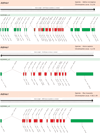Update on the aldehyde dehydrogenase gene (ALDH) superfamily
- PMID: 21712190
- PMCID: PMC3392178
- DOI: 10.1186/1479-7364-5-4-283
Update on the aldehyde dehydrogenase gene (ALDH) superfamily
Abstract
Members of the aldehyde dehydrogenase gene (ALDH) superfamily play an important role in the enzymic detoxification of endogenous and exogenous aldehydes and in the formation of molecules that are important in cellular processes, like retinoic acid, betaine and gamma-aminobutyric acid. ALDHs exhibit additional, non-enzymic functions, including the capacity to bind to some hormones and other small molecules and to diminish the effects of ultraviolet irradiation in the cornea. Mutations in ALDH genes leading to defective aldehyde metabolism are the molecular basis of several diseases, including gamma-hydroxybutyric aciduria, pyridoxine-dependent seizures, Sjögren-Larsson syndrome and type II hyperprolinaemia. Interestingly, several ALDH enzymes appear to be markers for normal and cancer stem cells. The superfamily is evolutionarily ancient and is represented within Archaea, Eubacteria and Eukarya taxa. Recent improvements in DNA and protein sequencing have led to the identification of many new ALDH family members. To date, the human genome contains 19 known ALDH genes, as well as many pseudogenes. Whole-genome sequencing allows for comparison of the entire complement of ALDH family members among organisms. This paper provides an update of ALDH genes in several recently sequenced vertebrates and aims to clarify the associated records found in the National Center for Biotechnology Information (NCBI) gene database. It also highlights where and when likely gene-duplication and gene-loss events have occurred. This information should be useful to future studies that might wish to compare the role of ALDH members among species and how the gene superfamily as a whole has changed throughout evolution.
Figures



References
-
- Sophos NA, Pappa A, Ziegler TL, Vasilou V. Aldehyde dehydrogenase gene superfamily: The 2000 update. Chem Biol Interact. 2001;130-132:323–337. - PubMed
-
- Sobreira TJ, Marletaz F, Simoes-Costa M, Schechtman D. et al.Structural shifts of aldehyde dehydrogenase enzymes were instrumental for the early evolution of retinoid-dependent axial patterning in metazoans. Proc Natl Acad Sci USA. 2011;108:226–231. doi: 10.1073/pnas.1011223108. - DOI - PMC - PubMed
-
- Estey T, Cantore M, Weston PA, Carpenter JF. et al.Mechanisms involved in the protection of UV-induced protein inactivation by the corneal crystallin ALDH3A1. J Biol Chem. 2007;282:4382–4392. - PubMed
Publication types
MeSH terms
Substances
Grants and funding
LinkOut - more resources
Full Text Sources
Other Literature Sources

